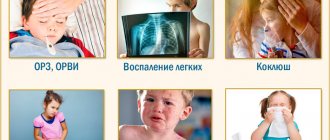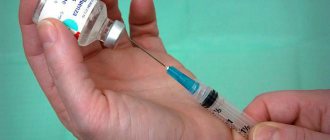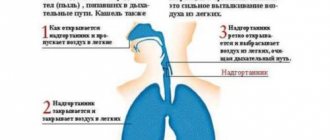Why does a child’s cough not go away for a long time?
In fact, coughing is a normal physiological process that does not pose any danger. With the help of coughing, the body gets rid of foreign substances (water, mucus, bacteria) or even objects. If the cough does not occur as a result of diseases, then it is defined as physiological; if due to any disease (ARVI, bronchitis, whooping cough, laryngotracheitis, pharyngitis, tracheitis), then such a cough is defined as pathological.
Physiological (normal) residual cough is characterized by the following symptoms:
- The cough appears in the morning, immediately after waking up, and practically does not bother you during the day.
- Shallow cough, without expectoration of sputum.
- There are no signs of infection - high fever, sputum production, lethargy, etc.
- After treatment for the underlying disease is completed, the cough becomes rare and less pronounced.
Thus, when the immune system is restored, it suppresses the cough on its own, and there is no need to use medications.
If, according to a parent, a persistent cough in a child is pathological, it is necessary to immediately contact a pediatrician to determine the cause and choose a treatment plan.
After ARVI
A cold is the most common cause of cough. Normally, with acute respiratory viral infections and acute respiratory infections, the cough goes away within 4-5 days after its onset. At the beginning of the disease, the cough is dry, after 1-2 days it becomes wet (productive); If the cough soon does not stop, or becomes more pronounced, this may indicate the development of a complication.
Help: If a child’s persistent cough does not go away after 2 weeks, you should consult a doctor.
Sometimes the cause of a lingering cough is prolonged use of mucolytic (sputum thinning) drugs - after the sputum begins to clear easily, the drugs should be replaced with plenty of fluids.
The duration of residual cough after acute respiratory viral infection can vary from 2 weeks to 1.5 months, and in the presence of a tendency to allergies - up to 2 months.
The duration of residual cough depends on several factors:
- type of cough - wet or dry. A dry residual cough without expectoration goes away faster, since with a wet cough it takes approximately twice as much effort to remove the sputum that has accumulated during an acute respiratory viral infection.
- the severity of the illness, whether there was a secondary viral or bacterial infection;
- the state of the child’s immune system - strong or weak immunity.
On this topic:
How and with what to treat a simple cough in a child: effective methods
The exact duration of residual cough is difficult to determine; in the absence of concomitant treatment, cough can persist for up to 5-6 months.
Usually, a residual cough during ARVI is considered normal, because it takes some time to restore the body and strengthen the immune system after an illness. However, if the cough is accompanied by difficulty breathing, the discharge of sputum with purulent contents, and an increase in body temperature, this indicates the development of complications. With such symptoms, the child should be shown to a pediatrician.
After bronchitis
Residual cough is quite common in children after bronchitis. This is characterized by the fact that children do not yet know how to expectorate sputum due to physiological characteristics. In addition, the bronchial mucosa in children takes much longer to recover than in adults. For these reasons, the cough may persist for some time after the end of treatment with a positive result.
Help: There is a misconception that residual cough after bronchitis is the result of the use of antibiotics. However, antibiotics have no effect on cough; moreover, treatment of bronchitis without such drugs takes longer and is more difficult.
Residual cough in a child after bronchitis can persist for 10-14 days, and in some cases up to 1 month. If the child is not bothered by other alarming symptoms, he feels well - there is no reason to worry.
You should pay attention if the following symptoms appear with a residual dry or wet cough:
- sore throat or chest pain;
- periodic or constant elevated body temperature;
- presence of wheezing when breathing;
- lack of appetite, decreased activity, deterioration in general health.
All this may indicate the development of pathological processes in the lungs, even inflammation, and requires immediate diagnosis.
Types of cough
Of course, a child’s dry cough does not just arise without reason. If your baby coughs a couple of times a day, there is nothing to worry about. It's completely natural. But when the cough becomes severe and continues for a long time, it’s time to sound the alarm and call specialists for help.
By nature, cough is divided into two main types:
- wet - it is also called productive, because when you cough, sputum appears, it is a viscous substance of a transparent or pale yellow color, from which you can determine the causative agent of the disease and prescribe adequate treatment;
- dry - this type is quite difficult to treat, often this type of cough does not go away for a long time in a child, which causes concern among parents; the reasons for its occurrence can be different.
Often, a cough becomes a residual phenomenon after a cold or inflammatory disease. It occurs because parents interrupted drug therapy too early or significantly reduced the dosage of medications. As a result, such a cough does not go away for a long time in a child and can last for several weeks. At the same time, it causes great discomfort, worsens the baby’s quality of life, makes him restless, irritable and nervous. Often, due to sudden attacks, the child cannot fall asleep for a long time, which entails lack of sleep, problems with attention, absent-mindedness, lack of appetite, physical lethargy, and generally undermines his immunity.
Why is a persistent cough dangerous?
A cough is a sudden expulsion of air from the respiratory tract using the muscles. And if an adult can tolerate a cough relatively easily, then a child, especially an infant, finds it difficult to expel mucus due to imperfections in the muscles of the respiratory tract. The mucus remains in the bronchi, which creates favorable conditions for the proliferation of pathogenic microorganisms and the development of complications; the cough becomes protracted.
A lingering cough can hide quite serious pathologies, and if treated incorrectly, precious time can be lost.
In addition, a prolonged cough, especially a dry one, exhausts the child’s not yet perfect nervous system.
What to do if your child’s cough with sputum does not go away for a long time
A wet (productive cough) indicates normal function of the mucous membrane of the respiratory tract and the removal of mucus. In most cases, to cleanse the bronchi, a dry cough must be converted into a wet one. For this purpose, mucolytic and expectorant drugs are used.
If, as a result of treatment, a child’s wet cough does not go away for a long time, it is necessary to resort to auxiliary methods for better removal of sputum - massage.
On this topic:
Causes and treatment of cough in a two-year-old child
Information: The course of taking mucolytic drugs should not exceed 7 days (except on the recommendation of a doctor); Long-term use of such drugs causes hypersecretion of the bronchial glands, as a result of which the cough persists for a long time.
In case of prolonged cough with sputum, antitussive drugs are excluded; their use for hypersecretion of the bronchial glands leads to stagnation of sputum with the likelihood of developing an inflammatory process.
Important! The appearance of pus, blood or other changes in sputum, weakness, fever or weight loss are alarming symptoms that require immediate medical attention. Such symptoms may indicate the presence of purulent-infectious processes requiring antibacterial therapy.
Causes of dry cough in a child
To effectively deal with this disease, you first need to determine what you have to deal with. If a child has a dry cough that does not go away for a long time, or sputum appears periodically when coughing, you should listen more carefully and determine its shape. This could be a cough:
- barking - often during coughing attacks in a child you can hear prolonged wheezing, which often indicates the viral nature of the disease and indicates damage to the larynx and trachea;
- hoarse - as a rule, it indicates chronic pathologies of the lungs, may indicate the development of bronchial asthma, in addition, such a cough can cause mechanical damage to the laryngeal mucosa;
- nocturnal - it appears in a sleeping baby when he lies on his back, this happens because mucus accumulates in the pulmonary ducts, as a rule, such a cough occurs in children with bronchial asthma;
- vomiting - such a cough manifests itself in attacks, it is usually quite strong, characterized by the release of a large amount of sputum, due to the need to catch the breath, the child cannot cope with a cough attack, because the sputum enters the stomach, and this process often provokes a gag reflex.
When a child has a dry cough that does not go away for a long time, the reasons for this phenomenon may be:
Features of the indoor microclimate. The optimal air humidity for a baby is 60-70%. When this indicator decreases, the mucous membrane of the throat begins to dry out and become irritated, which provokes the development of a cough. The same reaction occurs if the room is too stuffy, smoky, or has a lot of dusty surfaces.
- Acute bronchitis. Often this disease is accompanied by attacks of a strong barking cough. As a rule, it intensifies closer to night, which is why it can greatly exhaust the baby. A cough caused by bronchitis can also be determined by body temperature - it rises to 38-39 degrees.
- Inflammatory throat diseases such as laryngitis or pharyngitis. These pathologies can be identified by several characteristic signs. First of all, the mucous membrane of the larynx swells greatly, an unpleasant soreness and tickling sensation appears in the throat, the voice becomes low, and sometimes disappears completely.
- Whooping cough. A common disease among children. It is often confused with a cold or allergy, since the primary symptoms are quite similar: dry cough, fever, weakness. But with whooping cough, a child’s dry cough does not go away for a long time, and its attacks become more frequent and intense.
- Allergic reaction. If the baby is exposed to an allergen, he may develop a dry cough. Allergic cough can be distinguished from other diseases by accompanying signs that appear as a result of the action of the irritant: watery eyes, runny nose, sneezing, itching, the appearance of purple spots on the skin, redness of the face.
- Stressful situation, nervous overstrain. Sometimes, when a child’s cough does not go away for a long time, this may indicate an unstable psycho-emotional state of the child. The impetus for the development of stress and depression can be constant nervous or physical stress, a difficult atmosphere in the family, frequent quarrels, problems with peers, etc.
If a child develops a cough, especially if it does not go away for a long time, you should not engage in self-diagnosis and self-medication. To avoid serious consequences for your baby's health, be sure to consult a doctor. The specialist will prescribe the necessary types of tests, based on the results obtained, determine the cause of the cough and select the most appropriate treatment regimen.
Tips for treating a persistent cough
To properly treat a persistent cough in a child, the first step is to establish the cause of its occurrence, and only then begin treatment, following all the recommendations of the attending physician.
In addition to drug therapy prescribed by your pediatrician, parents can follow these tips for treating cough at home:
- The child must drink enough fluid - it thins the mucus in the respiratory tract, so recovery occurs faster.
- The air in the room where the child is located must be humidified - hanging wet towels, placing buckets and bowls of water around the room is allowed. In addition, it is recommended to carry out wet cleaning daily.
- Minimize contact with allergens.
After consultation and with the permission of the pediatrician, massage, inhalations and compresses can be performed to increase the effectiveness of the main treatment.
Inhalations and compresses
Inhalation is the most preferred method of using medicines in the treatment of cough in children, because with the help of steam, the medicine gets directly to the source of the disease. In addition, this reduces the risk of developing side effects of the drugs.
Help: Inhalations using inhalers and nebulizers are much more effective than traditional methods of inhaling hot steam, since with “homemade” inhalations the steam has a coarse structure, which is why it settles in the nasopharynx, not reaching the bronchi. Inhalers and nebulizers produce fine vapor, which penetrates much deeper into the respiratory tract.
Contraindications to inhalations are:
- fever;
- age less than 1 year;
- bacterial infection;
- the presence of traces of blood in the sputum.
Inhalations with medications should not be carried out independently without a pediatrician’s prescription; Before consulting a doctor, inhalations with saline are allowed - it moisturizes the airways well and reduces attacks of dry cough.
Compresses are a good alternative to mustard plasters; They do not irritate the baby's delicate skin. The most popular and effective are compresses made from vinegar, flour (2 tbsp each), honey and sunflower oil (1 tbsp each). Mix the ingredients, roll out the pancake, heat it in a water bath, then place it on top of the gauze on your chest. Cover the top of the compress with a scarf and leave for several hours.
On this topic:
Subtleties of treating cough in an infant
Massage
Properly performed therapeutic massage improves blood circulation and accelerates the release of phlegm from the lungs. Massage technique:
- Place the child on his stomach, stretch his arms forward, and place a small pillow under the pelvis.
- You need to start the massage with soft strokes on the back - this way the baby’s skin will warm up and prepare for further massage.
- Next, with a continuous soft movement, the hand is drawn along the spine, from the buttocks to the shoulder line - repeat several times.
- Then the back is rubbed, from the spine to the sides - in both directions.
- The next manipulation is light tapping with your fingers between the ribs, from bottom to top.
- If during the massage the child begins to cough, it is necessary to sit him upright.
For children under 1 year of age, a lighter version of the massage is performed: the palm is placed on the back at the location of the lungs, and light tapping is done with the other hand over the entire palm.
Help: This massage can only be performed if the child does not have a fever. Also, during the massage the child should not experience any pain.
Massage is an additional method to the main treatment; it cannot be used in the treatment of cough as an independent method.
Drug treatment
Depending on the type of cough, the following groups of drugs are used:
- mucolytics (ACC, Ambrobene, Lazolvan, Ambrobene, Gerbion) - aimed at thinning sputum;
- expectorants (Bromhexine, licorice root, Gedelix) - accelerate the discharge of sputum by stimulating the work of the epithelium of the respiratory tract;
- antitussives (Sinekod, Codelac, Tusidil) - inhibit the cough reflex, affecting the central nervous system.
Combination drugs are often prescribed that combine the effects of mucolytics and expectorants - Broncholitin, Ascoril, etc.
What to do if your child coughs for a long time
Only a doctor can decide how to treat a child’s persistent cough. Complex therapy can bring quick results. Therefore, a cough treatment regimen should include, in addition to taking medications, regular rubbing, chest and back massage, and inhalations.
Drug therapy
The problem of how to cure a cough that does not go away for 2 weeks is solved by eliminating the cause of its occurrence. The treatment regimen includes:
- Antihistamines - the child is prescribed Suprastin, Tavegil or Zyrtec to relieve swelling from the mucous membrane of the respiratory tract. Antitussive drugs Sinekod, Intussin or Glauvent are needed to relieve physiologically unjustified cough attacks (when the respiratory organs are clean).
- Antibiotics - used for pneumonia, to treat cough caused by a bacterial infection. Effective tablets Augmentin, Ceftriaxone, Kipferon suppress the activity of bacteria, relieve inflammation and swelling of the mucous membrane.
- Hormonal drugs - prescribed for blockage of the bronchi (obstructive bronchitis). Pulmicort, Berodual - these medications are used for dry cough for inhalation. They eliminate shortness of breath and restore breathing.
- Mucolytic agents. To make a dry cough moist, Tusuprex and Libexin are prescribed. For wet cough with difficult to separate sputum, ACC, Lazolvan, Prospan are prescribed.
- Multivitamin complexes. To strengthen the immune system and increase the body's resistance to bacteria, Complivit, Univit, Vitrum Kids are recommended.
Drainage massage
A condition in which a child’s cough does not go away for a week requires drainage massage:
- The child is placed on his stomach and a pillow is placed under the chest.
- The massage begins with a 5-minute warm-up of the back. Use your palms to perform various stroking, rubbing, and light pats. For better hand glide, use baby oil or cream.
- Over the next 5 minutes, lightly tap the ribs of both palms in the direction from the ridge to the sides, from the lower back to the shoulder blades.
- Finish the massage with soothing stroking.
Folk remedies
If a child’s cough does not go away for a long time, then, with the permission of the doctor, drug therapy can be supplemented with folk remedies.
Treatment of cough with folk remedies gives a milder effect. As a rule, all these techniques help not only fight the underlying infection, but also strengthen the immune system.
For example, this will help a lot:
- Onion syrup. Peel the onion, wash it, chop it, and squeeze out the juice using gauze. Add to it as much natural honey as you get juice. Take the medicine 3 times a day, 1 tbsp. l. Has an antimicrobial, anti-inflammatory effect.
- Honey warming compress. Honey is applied to the back. Compress paper is applied on top. The body is tied with a simple cloth to keep the compress in place. The procedure is carried out overnight until in the morning honey remains on the skin of the back instead of droplets of water. The compress helps remove mucus.
To quickly stop an attack of dry cough, you can give your child a little warm water or milk with honey.
Which doctors should I go to and which tests should I take?
In case of persistent cough or suspected pathology, parents should contact their local pediatrician, who, if necessary, will prescribe a number of necessary tests:
- CBC (complete blood count) - to exclude/confirm inflammatory processes in a child;
- biochemical blood test - to determine the functional state of organs and systems;
- chest x-ray;
- fluorography;
- spirometry – to assess respiratory function.
As an additional study, the pediatrician may prescribe the child an ECG, ultrasound examination of the abdominal organs and computed tomography.
If necessary, the pediatrician can refer the child for consultation with a pulmonologist, infectious disease specialist, phthisiatrician, etc.










